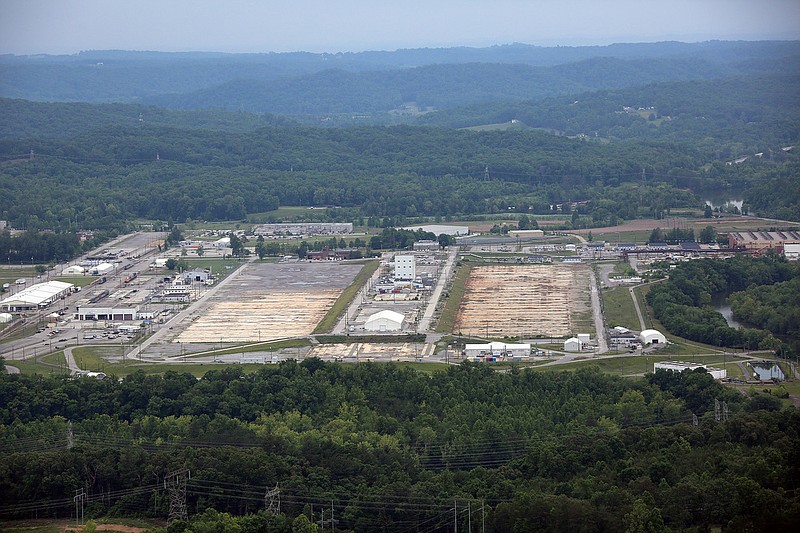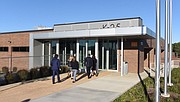OAK RIDGE, Tenn. - More than two decades after the cleanup began - and over a half century after most of the gaseous diffusion facility here shut down in the 1960s - the U.S. Department of Energy on Tuesday declared the 2,200-acre site cleaned up and ready for industrial reuse.
It is the largest completed cleanup project in Department of Energy history.
Since the 1990s, the federal government has spent more than $4.5 billion to demolish what was once the largest building in the world and remove and remediate tons of radioactive and chemical wastes left by the World War II-era complex. In its place, Gov. Bill Lee said, he hopes the East Tennessee Technology Park will serve as an incubator for the next phase of development in Oak Ridge, including a general aviation airport, a national park with a history museum and a nature preserve.
"Oak Ridge has a long history of future foresight and American exceptionalism and it's exciting to think what the future may hold here," Lee said during a ceremony heralded as "Vision 2020 done teardown to turnover."
"As we work to get our state's economy back, this is an incredible asset to create more business and more jobs in this community and to bring more innovation and technology to our state."
The K-25 building was built in 1943 as part of the Manhattan Project to build the world's first atomic bomb during World War II. At the time, K-25 was the largest building in the world with 5 million square feet under its roof, although few people knew of its existence in what military officials called "the secret city." In Oak Ridge, more than 25,000 scientists, engineers, soldiers and other workers and their families lived and helped develop the atomic bomb during World War II and, later, the first nuclear power plants and the world's fastest computers.
Jay Mullis, manager of the Department of Energy's Oak Ridge Office of Environmental Management, said the final stages of the K-25 cleanup were done by the contracting firm of UCOR four years earlier than originally forecast and $80 million below budget. By finishing ahead of schedule, the Department of Energy estimates the federal government saved $500 million in environmental and maintenance expenses.
"How often do you hear about a federal project coming in under budget?" Mullis said.
The Department of Energy still has decades of cleanup work. It will cost billions of dollars more to remediate contaminated sites elsewhere on the Oak Ridge reservation, with major projects ongoing at the Oak Ridge National Laboratory and the Y-12 weapons facility. Around the county, other Department of Energy nuclear sites also are having to be cleaned up in Washington, Idaho, New Mexico and elsewhere as the legacy of America's early experiments and work with nuclear weapons and nuclear power.
U.S. Sen. Lamar Alexander, the Tennessee Republican who is wrapping up an 18-year career in the U.S. Senate this fall and remains chairman of the key funding panel for the Department of Energy cleanup projects, said Oak Ridge distinguished itself by completing the environmental work ahead of schedule.
By the numbers
* $4.5 billion: Amount spent to clean up the site* 13.6 million: Square feet of building space demolished* 1.7 million: Cubic yards of waste dispositioned, which is equivalent to 520 Olympic-size swimming pools* $1.3 billion: Projected economic impact for East Tennessee from the East Tennessee Technology ParkSource: U.S. Department of Energy
"We appropriate a lot of money - $400 to $500 million a year - on cleanup work at DOE sites," Alexander said. "The difference between this site and others is that Oak Ridge gets it done. There's a long history along the Oak Ridge corridor of being first in doing what no one has done before."
U.S. Energy Secretary Dan Brouillette said he has visited the contaminated Department of Energy sites around the country "and I'm telling you that here in Oak Ridge it's done differently and it's a remarkable accomplishment.
"I don't know of any other place within the Department of Energy that operates as efficiently and as effectively as right here in Oak Ridge," Brouillette said during his visit here Tuesday.
Cleanup of the site included more than 500 facilities, at the heart of which were five massive uranium enrichment buildings. Since the site was officially closed in 1987, Department of Energy work has focused on transforming it into a multi-use industrial park, national park and conservation area. On part of the site an airport is planned for Oak Ridge, which is the biggest city in Tennessee that doesn't now have an airport.
Oak Ridge still faces huge challenges to clean up the mercury and other radioactive materials on other parts of the complex, including about 70 buildings that must be demolished and cleaned up in the coming years. U.S. Rep. Chuck Fleischmann, R-Tenn., chair of the House Nuclear Waste Cleanup Caucus, said even bigger environmental challenges exist at other Department of Energy facilities, including at Hanford, Washington, where nearly 200 tanks holding plutonium and other dangerous radioactive and chemical wastes remain buried on site.
"We won the Cold War and defeated the evil empire of the Soviet Union with what we did here at Oak Ridge and other facilities, but there was a time when we were not as careful with our nuclear arsenal," Fleischmann said. "The federal government has an obligation to clean these sites up."
Contact Dave Flessner at dflessner@timesfreepress.com or 423-757-6340.

